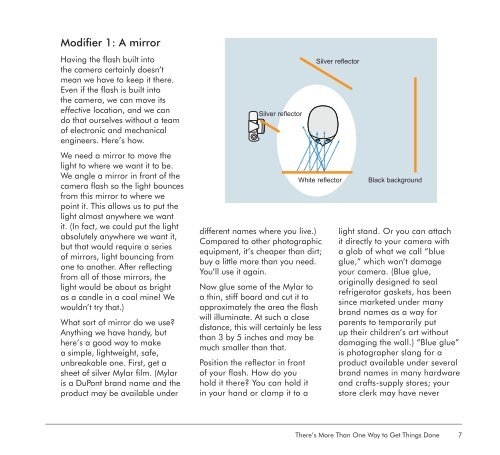Focus On Lighting Photos Focus on the Fundamentals.pdf
Create successful ePaper yourself
Turn your PDF publications into a flip-book with our unique Google optimized e-Paper software.
Modifier 1: A mirror<br />
Having <strong>the</strong> flash built into<br />
<strong>the</strong> camera certainly doesn’t<br />
mean we have to keep it <strong>the</strong>re.<br />
Even if <strong>the</strong> flash is built into<br />
<strong>the</strong> camera, we can move its<br />
effective locati<strong>on</strong>, and we can<br />
do that ourselves without a team<br />
of electr<strong>on</strong>ic and mechanical<br />
engineers. Here’s how.<br />
We need a mirror to move <strong>the</strong><br />
light to where we want it to be.<br />
We angle a mirror in fr<strong>on</strong>t of <strong>the</strong><br />
camera flash so <strong>the</strong> light bounces<br />
from this mirror to where we<br />
point it. This allows us to put <strong>the</strong><br />
light almost anywhere we want<br />
it. (In fact, we could put <strong>the</strong> light<br />
absolutely anywhere we want it,<br />
but that would require a series<br />
of mirrors, light bouncing from<br />
<strong>on</strong>e to ano<strong>the</strong>r. After reflecting<br />
from all of those mirrors, <strong>the</strong><br />
light would be about as bright<br />
as a candle in a coal mine! We<br />
wouldn’t try that.)<br />
What sort of mirror do we use?<br />
Anything we have handy, but<br />
here’s a good way to make<br />
a simple, lightweight, safe,<br />
unbreakable <strong>on</strong>e. First, get a<br />
sheet of silver Mylar film. (Mylar<br />
is a DuP<strong>on</strong>t brand name and <strong>the</strong><br />
product may be available under<br />
Silver reflector<br />
different names where you live.)<br />
Compared to o<strong>the</strong>r photographic<br />
equipment, it’s cheaper than dirt;<br />
buy a little more than you need.<br />
You’ll use it again.<br />
Now glue some of <strong>the</strong> Mylar to<br />
a thin, stiff board and cut it to<br />
approximately <strong>the</strong> area <strong>the</strong> flash<br />
will illuminate. At such a close<br />
distance, this will certainly be less<br />
than 3 by 5 inches and may be<br />
much smaller than that.<br />
Positi<strong>on</strong> <strong>the</strong> reflector in fr<strong>on</strong>t<br />
of your flash. How do you<br />
hold it <strong>the</strong>re? You can hold it<br />
in your hand or clamp it to a<br />
Silver reflector<br />
White reflector Black background<br />
light stand. Or you can attach<br />
it directly to your camera with<br />
a glob of what we call “blue<br />
glue,” which w<strong>on</strong>’t damage<br />
your camera. (Blue glue,<br />
originally designed to seal<br />
refrigerator gaskets, has been<br />
since marketed under many<br />
brand names as a way for<br />
parents to temporarily put<br />
up <strong>the</strong>ir children’s art without<br />
damaging <strong>the</strong> wall.) “Blue glue”<br />
is photographer slang for a<br />
product available under several<br />
brand names in many hardware<br />
and crafts-supply stores; your<br />
store clerk may have never<br />
There’s More Than <str<strong>on</strong>g>On</str<strong>on</strong>g>e Way to Get Things D<strong>on</strong>e<br />
7



